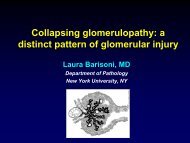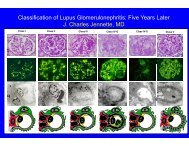An Algorithmic Approach to Renal Biopsy Interpretation of ...
An Algorithmic Approach to Renal Biopsy Interpretation of ...
An Algorithmic Approach to Renal Biopsy Interpretation of ...
You also want an ePaper? Increase the reach of your titles
YUMPU automatically turns print PDFs into web optimized ePapers that Google loves.
Step 4: Electron microscopic examination. Electron microscopy is not essential for thediagnosis <strong>of</strong> most forms <strong>of</strong> glomerular disease, but EM is helpful in many diseases for furtherconfirmation and nuanced observations, EM is required for some diagnoses (e.g. fibrillaryGN, immunotac<strong>to</strong>id glomerulopathy, thin basement membrane nephropathy), and EM ishelpful in recognize unsuspected categories <strong>of</strong> disease that were not recognized by LM or IM(e.g. hereditary nephritis, collagen<strong>of</strong>ibrotic glomerulopathy, Fabry disease).Figure 3. Diagrams and electron micrographs <strong>of</strong> some <strong>of</strong> the glomerular capillary changesthat must be discerned when evaluating glomerulonephritis by electron microscopy. A)mesangial electron dense deposits, B) subendothelial electron dense deposits, C) subepithelialhump-like electron dense deposits (postinfectious GN), D) subendothelial dense deposits withmesangial interposition (type I MPGN).





